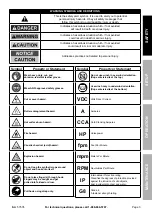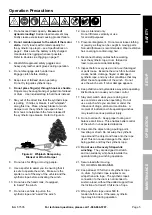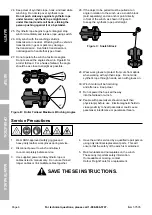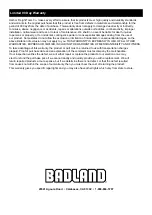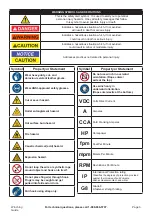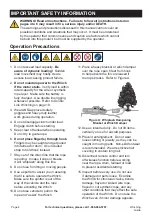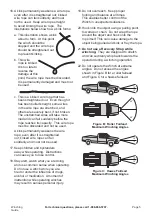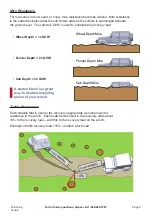
Page 12
For technical questions, please call 1-888-866-5797.
Item 57535
SAFE
TY
O
PERA
TI
O
N
M
A
INT
EN
A
N
CE
SE
TU
P
14. Do not operate the Winch at extreme angles.
Do not exceed the angles shown in Figure B for
a roller fairlead. For a hawse fairlead, the angle
should be as close to straight as possible.
15°
15°
45°
45°
Figure B: Roller Fairlead Maximum Winching Angles
15. If the object to be pulled must be pulled at an
angle in relation to the Winch, use a snatch block
(sold separately) and an anchor point directly
in front of the Winch, as shown in Figure C,
to keep the Synthetic Rope pull straight.
Figure C: Snatch Block
16.
WARNING! TO PREVENT SERIOUS
INJURY:
Stop the Winch and release tension
on the Synthetic Rope before moving the
blanket or winch damper placed on it.
17. Do not continue use of the Winch until
the battery is completely run down.
18. When possible, keep the engine running while using
this Winch, to continually recharge the battery and
prevent the battery from being drained so much that
the vehicle cannot start. However, exercise extreme
caution when working around a running vehicle
and ONLY operate a vehicle in an outdoor area.
CAUTION!
Do not use the Winch in a
constant duty application, it is designed for
INTERMITTENT USE ONLY. Keep the duration
of the pulling job as short as possible. If the
motor becomes very hot to the touch, stop and
let it cool down for several minutes. Do not pull
for more than one minute at or near the rated
load. Do not maintain power to the Winch if
the motor stalls. Double Line Rigging will help
prevent overloading and should be used whenever
practical. See
Double Line Rigging
on page 11.
19. When finished pulling the load, reverse the direction
of the Winch just enough to release tension on
the Synthetic Rope so that you can unfasten
the Hook from the load and reel in the Rope.
20. Disconnect the Remote Control
(if equipped) after use.
Duty Cycle (Duration of Use)
at least
14 minutes,
15 seconds
of rest
45 seconds winching
Avoid damage to the Winch by not winching
for more than the prescribed duty cycle time.
The Duty Cycle defines the amount of time, within
a 15 minute period, during which a Winch can
operate at its maximum capacity without overheating.
For example, this Winch with a 5% duty cycle at its
maximum load must be allowed to rest for at least
14 minutes, 15 seconds after every 45 seconds of
continuous operation. Failure to carefully observe
duty cycle limitations can easily over-stress a
Winch contributing to premature Winch failure.



